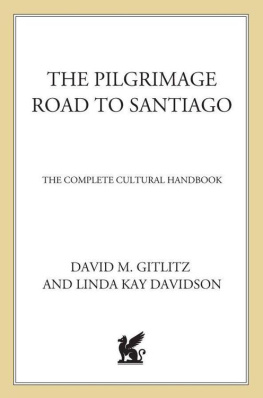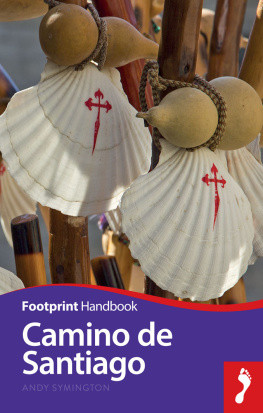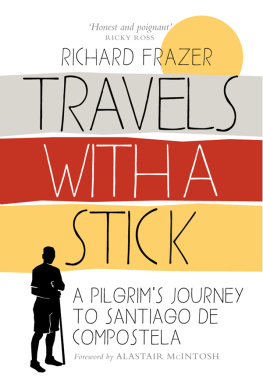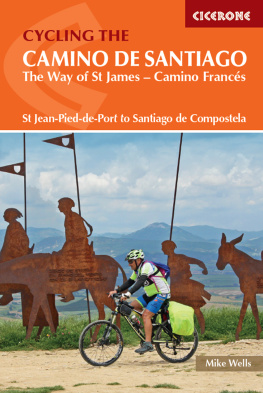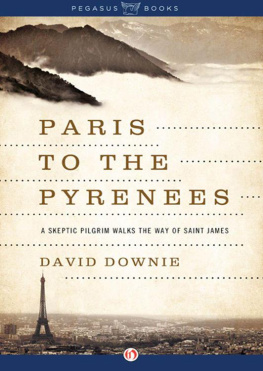The author and publisher have provided this e-book to you for your personal use only. You may not make this e-book publicly available in any way. Copyright infringement is against the law. If you believe the copy of this e-book you are reading infringes on the authors copyright, please notify the publisher at: us.macmillanusa.com/piracy.
In 1974, 1979, 1987, 1993, and 1996 we walked to Compostela, accompanying groups of college studentpilgrims on academic medieval studies programs, sponsored successively by Indiana University, the University of Nebraska, Binghamton University, and the University of Rhode Island. This book began with our notes for those treks.
We dedicate this Handbook to Deborah and Abby Gitlitz and to all the other student pilgrims for their friendship, their infectious curiosity, their illuminating insights, and for fully indulging our enthusiasm for the Road.
The evaluations of artistic monuments and interrelationships between history, art, and pilgrimage are ours, based on decades of reading and hours of wonderful conversations with knowledgeable colleagues, priests and nuns, farmers and townsfolk, bartenders and jalers, local historians and mystics, hospitallers and vagabonds, sabios and sapos, whom we have encountered on the Road. Our several walking pilgrimages have given us insights unattainable by any other means. We have indicated source material and direct quotations where appropriate, of course. We take full responsibility for errors and omissions. We realize that there will be differences of opinion regarding some of our conclusions, and we welcome comments from readers that will help us prepare for subsequent editions of this book.
We especially thank Kristen Macnamara at St. Martns Press and Jeanne Fredericks for having faith in the project; Christopher Hewitt, who did footwork for us in the library while we were on the Road in 1998; Ann Suter for her help with the Latin translations; and the University of Rhode Island librarians who helped us make deadlines. To Abigail Gitlitz, who did the artwork and maps for this volume, and to David Publow, who lettered them, we can only say, Gracias, mil gracias.
When we first trekked to Compostela in 1974 we did not meet even one other pilgrim on the Road. In 1979 the only pilgrim we encountered was an elderly Frenchman who was fulfilling a vow made in the Second World War. To most people in the 1970s the pilgrimage Road was hardly more than a vague memory of a historical relic: You know, in medieval times .
Davids imagination had been fired by Walter Starkies vivid account of his pilgrim experiences in the 1950s, and he had pulled together an American college group. Together we searched out the old paths, consulting army maps and asking directions from farmers plowing their fields with braces of oxen. Linda saw her first storks nest (when do they return to Spain for summer?). We discovered Romanesque sculpture (what is that snake doing to that woman?). In the smallest villages we saw crumbling palaces and big barns of churches, and we wondered how these hamlets ever could have afforded to cut so much stone. Every kilometer generated questions.
For twenty-five years we have sought answers to those questions. In 1987 and 1993 we met hundreds of other pilgrims along the Road. In 1996, a Holy Year, more than 100,000 pilgrims walked the Road to Compostela. In their company we limped out of the Pyrenees, toasted our necks in the hot sun of the Meseta, and bowed under our backpacks as we struggled up the mountains to O Cebreiro. When our group stopped for a lesson, most walked on by. But every so often some fellow pilgrims would pause as we stared at a line of rocks in a seemingly empty field. What are you looking at? Thats where a Roman villa used to be, we answered. See? Thats the outline of an ancient building. Sometimes pilgrims clustered around our group as we retold the stories narrated on some church portal. Sometimes we drew a small crowd as we recited a medieval poem that recounted events that took place in the very building we were looking at. The urging behind all those pilgrim voices saying, I wish we knew more, is why we have written this book.
Whatever your motive for making this pilgrimage, you will learn that the Road is more than dust and pain and friendships and the endlessly receding western horizon. It is history and poetry, snow-capped mountains and bloodred poppies, Romanesque capitals and Gothic spires, oak forests and sheep bells, and wedge-tailed black kites soaring overhead. Look up. Look around. If it takes you an extra few days to get involved with what you are walking through, in the long run you will judge it time well spent. You will learn what all of our pilgrim companions have learned on the Santiago Road: the going is more memorable than the getting there.
Our book is not a route guide. The Road to Santiago is so well marked now that its hard not to find your way west without getting lost. You may have already chosen a route guide. For hikers, the translations of the Milln Bravo Lozano or the Valia Sampedro guides and the shorter guide by the British Confraternity are all popular. There are special guides for bikers and motorists, and new guides seem to come out every other day. Neither do we suggest lodgings or restaurants. That sort of information goes out-of-date almost as fast as it is printed. And besides, with the modern boom in the pilgrimage, the numbers of refugios sprouting up all along the Road make it easy to find lodging almost anywhere.
What you are holding is your Handbook to the cultural contexts of the pilgrimage. It is meant to accompany your route guide, to be the second item you put into your knapsack. From the Pyrenean border between France and Spain we will walk with you, providing useful and interesting information about the history, people,natural environments, and artistic monuments that you are passing. At the back of the book you will find a timeline of monarchs and handy glossaries of the saints, artists, and artistic styles you will encounter every day. With luck, by the end of your pilgrimage you wont need the glossaries anymore. We have concentrated on things you would have seen if you had been a pilgrim in the Middle Ages, but we dont completely ignore modern times either. As you walk, it is what you see that engages your attention, so it will come as no surprise that our book focuses on the visual, particularly the splendid art arrayed along the Road. Since understanding what you see is a function of what you know, you will also find information about the historic, literary, and religious contexts of the pilgrimage and the pilgrimage Road.
So, as you pack up your gear, a couple of reminders. In the outside compartments of your knapsack, along with your water bottle, your route guide, and this book, stash a lightweight pair of binoculars and a small flashlight with a strong, focused beam for looking at monuments. Dont neglect to get your pilgrims credential, or passport, which will admit you to the pilgrim refugios. The American Friends of the Road to Santiago [dgitlitz @ aol.com] is pleased to supply you with one. Or you can pick one up at St.-Jean-Pied-de-Port or Roncesvalles, if you wish. If you are traveling other routes, you should be able to acquire one in one of the early larger towns or refugios. Dont forget to carry some money. But, most of all, fill your pockets with curiosity.
THE PILGRIMAGE TO SANTIAGO DE COMPOSTELA
The story of St. James has been written so often as to be trite in its retelling. Honed over centuries of discoveries, interpretations, claims, and counterclaims, it lies somewhere between legend and fact, between superstition and belief. Yet whether it is true or only wished to be true, it has motivated pilgrimages for 1,000 years. It is why you are on the Road. What follows is the most prevalent version of the story of the Apostle James, with the addition of some historical material that is perhaps not quite so widely known.

